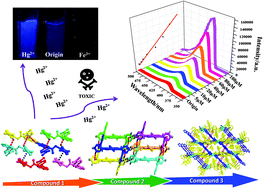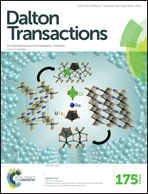Highly sensitive and selective fluorescent probes for Hg2+ in Ag(i)/Cu(ii) 3D supramolecular architectures based on noncovalent interactions†
Abstract
Three novel metal–organic assemblies (MOAs), namely, [Ag(2,4′-Hpdc)(4,4′-bpy)]n (1), [Ag(2,2′-Hpdc)(4,4′-bpy)0.5]n (2), and [Cu(2,2′-Hpdc)2(1,4-bib)]n (3) [2,4′-H2pdc = 2,4′-biphenyldicarboxylic acid; 2,2′-H2pdc = 2,2′-biphenyldicarboxylic acid; 4,4′-bpy = 4,4′-bipyridine; 1,4-bib = 1,4-bis(1-imidazolyl)benzene] have been hydrothermally synthesized by using mixed ligands and characterized by single crystal X-ray diffraction, infrared (IR), elemental analysis and thermogravimetric analysis (TGA). The crystal structures of the three compounds indicate that the hydrogen bonding (C–H⋯O and C–H⋯π) and π⋯π stacking interactions play critical roles in the formation of an extended supramolecular array. The combination of C–H⋯π and π⋯π stacking interactions endow 1 with a 3D network. 2 displays a rare 3D structure with a unique 1D structure based on an eight-membered {Ag2C2O4} ring and compound 3 shows a 1D chain structure, which is propagated to form an extended 3D structure only by C–H⋯π hydrogen bonding. The two Ag(I)-compounds display blue emissions in the solid state at 298 K and 77 K. More significantly, compound 1 shows excellent selectivity, fast detection time (<5 min), and high sensitivity (detection limit, 9.63 nM) for Hg2+ ions in aqueous solution due to a great enhancement of 1-luminescence, which can be attributed to Hg2+ cation binding by a non-coordinated carboxyl group efficiently. This is a rare example of Hg2+ detection in aqueous solution based on luminescent silver MOAs. In addition, adsorption spectra reveal the semiconductive nature (2.76 eV for 2, but not detected for 1), thus the role of the Ag⋯Ag interaction in controlling the performance of the semiconductor properties is highlighted.


 Please wait while we load your content...
Please wait while we load your content...